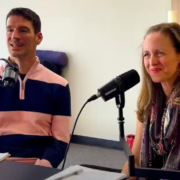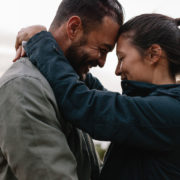Experiential therapy will take you farther.
What’s more convincing? (words or body language)
- A male client emphatically saying he’s not angry, yet he’s sitting in my office chair with his right middle finger up on his temple and his left arm crossed on his chest underneath the right arm?
- A spouse verbally declaring that she trusts her husband, yet her body remains stiff and her face full of anxiety as she does a trust catch into his arms?
- A mother verbally expressing her hurt that her teenage son avoids her by holing himself up in his room, yet when she role plays the solution with her family, she gives her son the role of playing basketball with his friends and she goes for a walk with her husband. (She was actually hurt by her husband’s distance.)
I am amazed time and time again by the information that surfaces when I guide clients to participate in experiential therapy exercises and have them tune into the messages their bodies, unconscious thoughts & emotions are expressing. With research to support that more of our communication is nonverbal, it is crucial that we include the wisdom of your body as well as your words in your therapy sessions.
Deep down, we all want to heal and be known and seen.
The truth- that we crave to know- often remains hidden either because our unconscious protects us from it or we fear the consequences of it being revealed, such as judgment by others, conflict, or a relationship ending. I strive to align with the part of you that desires healing and authentic connection in order to let go (at your pace) of the protective parts that are holding you back from experiencing the relationships and life you desire. By creating a safe, compassionate, and honest space and collaborating with you, you can be more fully yourself.
Beyond talk therapy for more effective results.
By guiding you to slow down, get present, and truly see what’s happening (in real time in a session or by video playback for couples and families with permission to film the session), I will gently guide you all to look at what your family member’s and your own actions are saying and to choose more effective ways to interact with your loved ones.
My clients often express feeling validated and relieved to hear that someone finally understands how they truly feel and what they have been attempting to communicate. You also will likely feel empowered to hear that if you hone this “superpower” of attuning to (or “reading”) others, your relationships will significantly improve. Or, even if it can be tough at times to see the truth, you can finally address the challenges your gut has sensed much sooner than in talk therapy.
Benefits of Experiential Therapy:
Evidenced-based and Life Changing
World-renowned therapist and expert in trauma Bessel Van Der Kolk shares his research that supports experiential therapies in his book, The Body Keeps the Score. He found that all three modalities below benefit trauma survivors:
- Top down strategies, ex. talk therapy
- Medications, ex. anti-depressant
- Bottom up techniques (experiential therapies)
However, Van Der Kolk focused his book more on the lesser known experiential therapies because he has found that clients in general (not just trauma survivors) need a combination of modalities to help us heal and change. I encourage clients to participate in experiential therapies in my office, with other professionals who provide modalities in which I do not have training (ex. EMDR, Biofeedback) and in the community (ex. Self-defense class, Psychodrama, Rock Climbing) for deeper, longer-lasting change. When I participated in my first IMPACT Personal Safety of CO’s self-defense class, all 12 women in my class expressed that their experience was life changing in ways we never would have imagined- both healing our past and empowering us in the present.
Experiential Couples Therapies
EFT (Emotionally Focused Therapy) has found that the two most important components that lead to change are: “the depth of emotional experiencing in session and the gradual shaping of interactions to help partners to clearly express fears and needs and to move towards more positive responding with each other. This is done through enactments” (Rosman).
PACT (Psychobiological approach to couples therapy) is an experiential relational model used specifically for couples therapy. PACT was developed out of cutting-edge research in three areas: neuroscience, arousal regulation, and attachment theory. For more information about how I use PACT, click here.
Practical Exercises that Create Change
Couples and families find that doing real exercises in my office or workshops in expressing feelings and needs, sharing appreciations, working through conflicts, etc. increases their confidence and competence in using these skills outside of sessions. To deepen the exercises and encourage more honest expression, I utilize a “show me” or “show your loved one” (your problem, solutions, feelings, secret longings, hidden pain, relationship dynamics, etc.) method of therapy to help clients get to the core of their impasse in order to move beyond it.
Creative, Playful, and Fun (for non-artists!)
When clients engage in expressive arts exercises, I see a different side of them. I often hear laughter, people taking themselves less seriously, and even having fun! It feels safer for many individuals to express their authentic feelings and thoughts through creative modalities. By incorporating art, writing, drama, and sand therapy, I support you in telling your story and more fully expressing yourself. Movement therapy also allows clients to access their bodies’ wisdom (or intuition), emotions, and memories.
Empowering for All Family Members
Experiential therapy empowers every family member to have an equally important voice because children and even adults feel freer to express their genuine selves when they are outside the box of verbal language in which we learn to censor ourselves. For example, if a father is used to having more power and voice at home, this will stymie the therapeutic process if I only utilize talk therapy. However, when I incorporate a creative non-verbal, visual, and/or movement exercise and especially a playful intervention, all family members are better able to express their perspective and see one another’s experiences through each other’s eyes. Examples are children’s drawings, teen’s psychodrama scenes, couple’s sandtrays, etc.
Introspective Techniques
Experiential techniques help individuals move new information and experiences through our bodies or from our mind down into our heart and intuition, which leads to longer lasting change. Through mindfulness meditation and other introspective forms of reflection (ex. writing, empty chair, or other expressive arts), you can experience catharsis, clarity, peace, and greater wisdom into yourself and your relationships.
My first dance therapy piece, “Addiction Divides Us, Recovery Unites Us” brought me closure, healing, and freedom. This dance piece is comprised of a group of “family members” who came together to create a piece depicting the family’s experience of addiction and recovery.
In summary
Art can heal. Whether it’s music, writing, visual art, theater, dance or something else, telling your story or resonating with someone’s else’s experience can be a cathartic experience. Sometimes words or “talk therapy” are too limiting and we long for a more powerful way to convey our journey.
Whatever is your story, I hope you will courageously share it with the method that is most effective for you.
If you are seeking therapy that incorporates experiential and creative methods: Contact Lana Isaacson, LCSW, CAS, Certificate in Marriage & Family Therapy at 720.939.2189, [email protected], or schedule your free consultation on my online calendar.







